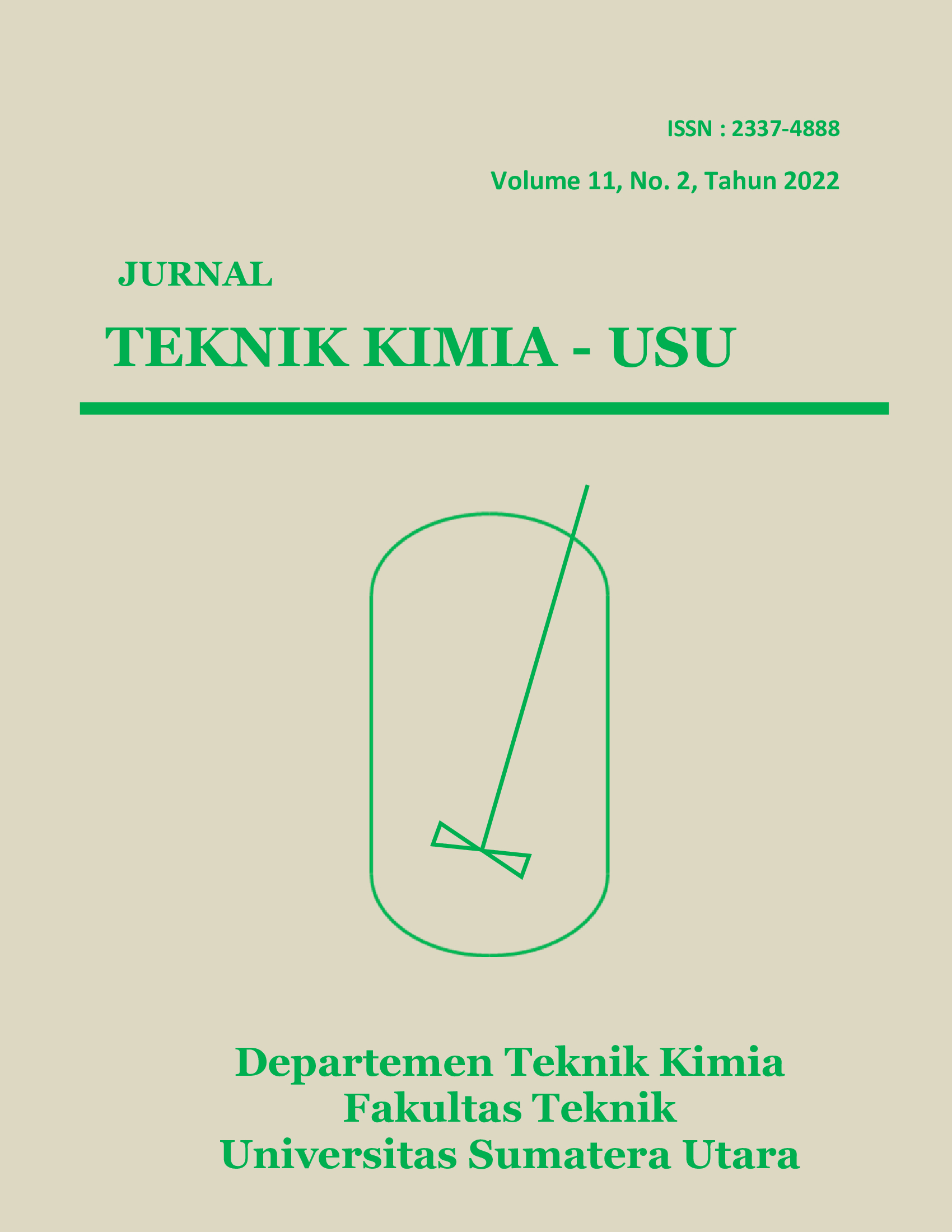Pengaruh Konsentrasi Kapang dan Lama Waktu Fermentasi terhadap Kadar Bioetanol dari Limbah Kulit Singkong (Manihot esculenta)
DOI:
https://doi.org/10.32734/jtk.v11i2.8279Keywords:
bioethanol, cassava peel, acid hydrolysis, fermentation, distillationAbstract
The purpose of this research is the manufacture of bioethanol by utilizing cassava peel, this process is through acid hydrolysis and fermentation processes. Making bioethanol with variations in the effect of the rate of fermentation time (5th days and 10th days), as well as with variations in the amount of mold concentrations (10%, 20%, and 30%). The mold used is Saccharomyces cerevisiae, then the mixed bioethanol is separated through the distillation process and will produce bioethanol. Based on the data obtained, the highest ethanol content was found in the variation of the addition of 30% mold on the 5th day of 8.09% and the lowest ethanol content was found in the variation of the addition of 10% mold on the 10th days of 5.86%. This proves that each variation has an optimum value in producing bioethanol content from cassava peels.
Downloads
References
N. M. Sari, S. R. Muria, and E. Yeni, “Produksi bioetanol dari limbah kulit nanas menggunakan bakteri Clostridium acetobutylicum dengan variasi konsentrasi inokulum dan penambahan nutrisi,†J. Fteknik, vol. 5, pp. 1–6, 2018.
Erna, I. Said, and P. H. Abram, “Bioetanol dari limbah kulit singkong (Manihot Esculenta Crantz) melalui proses fermentasi,†J. Akad. Kim., vol. 5, no. 3, pp. 121–126, 2016.
I. F. Nata, J. H. Prayogo, and T. Arianto, “Produksi bioetanol dari alkali-pretreatment jerami padi dengan proses simultaneous sacharification and fermentation (SSF),†Konversi, vol. 3, no. 1, pp. 10–16, 2014.
A. Artiyani and E. S. Soedjono, “Bioetanol dari limbah kulit singkong melalui proses hidrolisis dan fermentasi dengan Saccharomyces cerevisiae,†Pros. Semin. Nas. Manaj. Teknol. XIII, 2011, no. 1-8.
D. Guntama, Y. Herdiana, U. A. Sujiana, R. L. Endes, and E. Sunandar, “Bioethanol dari limbah kulit singkong (manihot esculenta crantz) melalui metode hidrolisa dan fermentasi dengan bantuan Saccharomyces cerevisiae,†J. Teknol., vol. 7, no. 1, pp. 86–96, 2019.
Hermansyah, T. Xayasene, N. Huu Tho, M. Miksusanti, Fatma, and A. T. Panagan, “Bioethanol production from cassava (Manihot Esculenta) peel using yeast isolated from durian (Durio Zhibetinus),†J. Phys. Conf. Ser., vol. 1095, no. 1, pp. 1–8, 2018.
P. Widyastuti, “Pengolahan limbah kulit singkong sebagai bahan bakar bioetanol melalui proses fermentasi,†J. Kompetensi Tek., vol. 11, no. 1, pp. 41–46, 2019.
T. Mutiara, S. Widiawati, S. Rachmatyah, and A. Chafidz, “Production of bio-ethanol via hydrolysis and fermentation using cassava peel and used newspaper as raw materials,†Mater. Sci. Forum, vol. 981, pp. 222–227, 2020.
R. Muin, D. Lestari, and T. W. Sari, “Pengaruh konsentrasi asam sulfat dan waktu fermentasi terhadap kadar bioetanol yang dihasilkan dari biji alpukat,†J. Tek. Kim., vol. 20, no. 4, pp. 1–7, 2014.
Z. Abidin, E. Saraswati, and T. Naid, “Bioethanol production from agro wastes by acid hydrolysis and fermentation process,†Int. J. PharmTech Res., vol. 6, no. 4, pp. 1209–1212, 2014.
D. Anggriani, U. Kalsum, and N. Nurjannah, “Pengaruh konsentrasi enzim silanase dan Saccharomyces cerevisiae dalam pembuatan bioethanol dari limbah kulit singkong dengan proses sakarifikasi dan fermentasi simultan,†J. Chem. Process Eng., vol. 5, no. 2, pp. 44–49, 2020.
R. Muin, I. Hakim, and A. Febriyansyah, “Pengaruh waktu fermentasi dan konsentrasi enzim terhadap kadar bioetanol dalam proses fermentasi nasi aking sebagai substrat organik,†J. Tek. Kim., vol. 21, no. 3, pp. 59–69, 2015.
Surati, “Konsentrasi S. cereviceae dan lama fermentasi terhadap kadar etanol limbah jerami padi,†J. Fikratuna, vol. 7, no. 2, pp. 1–11, 2015.
E. M. Widyanti and B. I. Moehadi, “Proses pembuatan etanol dari gula menggunakan Saccharomyces cerevisiae amobil,†Metana, vol. 12, no. 2, pp. 31–38, 2016.
N. T. Wahyudi, F. F. Ilham, I. Kurniawan, and A. S. Sanjaya, “Rancangan alat distilasi untuk menghasilkan kondensat dengan metode distilasi satu tingkat,†J. Chemurg., vol. 1, no. 2, pp. 30–33, 2017.
M. A. Batutah, “Ditilasi bertingkat bioetanol dari buah maja (Aegle Marmelos L.),†J. IPTEK, vol. 21, no. 2, pp. 9–18, 2017.
R. H. Perry and D. W. Green, Perry’s chemical engineers’ Handbook, 7th ed., Singapore: McGraw-Hill Book Company, 1999.
H. Y. Sriyana and U. Nasita, “Karakteristik Bioetanol Hasil Fermentasi Kulit Singkong,†J. Inov. Tek. Kim., vol. 4, no. 2, pp. 1–5, 2019.
W. Ferdaus, F., Wijayanti, M.O., Retnoningtyas E.S., Irawati, “Pengaruh pH, konsentrasi substrat, penambahan kalsium karbonat dan waktu fermentasi terhadap perolehan asam laktat dari kulit pisang,†Widya Tek., vol. 7, no. 1, pp. 1–14, 2008.
S. Bahri, A. Aji, and F. Yani, “Pembuatan bioetanol dari kulit pisang kepok dengan cara fermentasi menggunakan ragi roti,†J. Teknol. Kim. Unimal, vol. 7, no. 2, pp. 85–100, 2019.
Downloads
Published
Issue
Section
License
Copyright (c) 2022 Jurnal Teknik Kimia USU

This work is licensed under a Creative Commons Attribution-ShareAlike 4.0 International License.

















